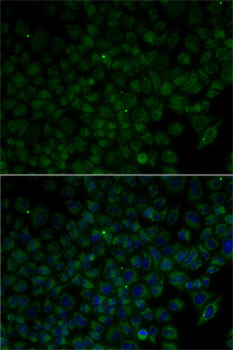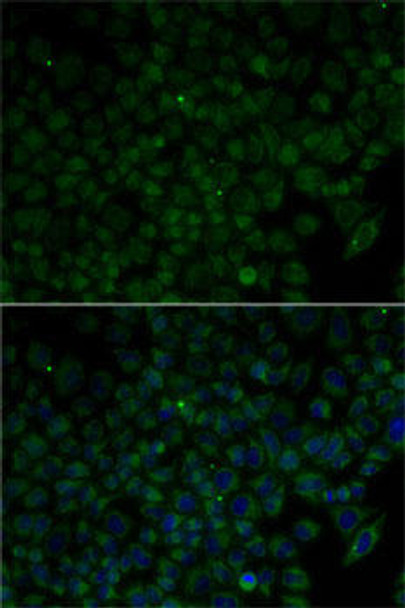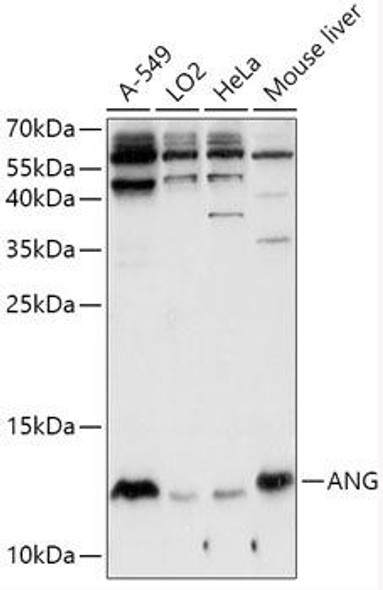Cardiovascular Antibodies
Anti-ANG Antibody (CAB1546)
- SKU:
- CAB1546
- Product Type:
- Antibody
- Reactivity:
- Human
- Host Species:
- Rabbit
- Isotype:
- IgG
- Antibody Type:
- Polyclonal Antibody
- Research Area:
- Cardiovascular
Description
| Antibody Name: | Anti-ANG Antibody |
| Antibody SKU: | CAB1546 |
| Antibody Size: | 20uL, 50uL, 100uL |
| Application: | IHC IF |
| Reactivity: | Human |
| Host Species: | Rabbit |
| Immunogen: | Recombinant fusion protein containing a sequence corresponding to amino acids 25-147 of human ANG (NP_001091046.1). |
| Application: | IHC IF |
| Recommended Dilution: | IHC 1:50 - 1:200 IF 1:50 - 1:200 |
| Reactivity: | Human |
| Positive Samples: |
| Immunogen: | Recombinant fusion protein containing a sequence corresponding to amino acids 25-147 of human ANG (NP_001091046.1). |
| Purification Method: | Affinity purification |
| Storage Buffer: | Store at -20'C. Avoid freeze / thaw cycles. Buffer: PBS with 0.02% sodium azide, 50% glycerol, pH7.3. |
| Isotype: | IgG |
| Sequence: | QDNS RYTH FLTQ HYDA KPQG RDDR YCES IMRR RGLT SPCK DINT FIHG NKRS IKAI CENK NGNP HREN LRIS KSSF QVTT CKLH GGSP WPPC QYRA TAGF RNVV VACE NGLP VHLD QSIF RRP |
| Gene ID: | 283 |
| Uniprot: | P03950 |
| Cellular Location: | Nucleus, Secreted, basement membrane, extracellular matrix, extracellular space, nucleolus |
| Calculated MW: | 16kDa |
| Observed MW: |
| Synonyms: | ANG, ALS9, HEL168, RAA1, RNASE4, RNASE5 |
| Background: | The protein encoded by this gene is an exceedingly potent mediator of new blood vessel formation. It hydrolyzes cellular tRNAs resulting in decreased protein synthesis and is similar to pancreatic ribonuclease. In addition, the mature peptide has antimicrobial activity against some bacteria and fungi, including S. pneumoniae and C. albicans. Alternative splicing results in two transcript variants encoding the same protein. This gene and the gene that encodes ribonuclease, RNase A family, 4 share promoters and 5' exons. Each gene splices to a unique downstream exon that contains its complete coding region. |
| UniProt Protein Function: | ANG: May function as a tRNA-specific ribonuclease that abolishes protein synthesis by specifically hydrolyzing cellular tRNAs. Binds to actin on the surface of endothelial cells; once bound, angiogenin is endocytosed and translocated to the nucleus. Angiogenin induces vascularization of normal and malignant tissues. Angiogenic activity is regulated by interaction with RNH1 in vivo. Defects in ANG are the cause of susceptibility to amyotrophic lateral sclerosis type 9 (ALS9). ALS is a degenerative disorder of motor neurons in the cortex, brain stem and spinal cord. ALS is characterized by muscular weakness and atrophy. Belongs to the pancreatic ribonuclease family. |
| UniProt Protein Details: | Protein type:RNA-binding; Secreted, signal peptide; Ribonuclease; EC 3.1.27.-; Secreted; Motility/polarity/chemotaxis; Nucleolus; Extracellular matrix; Cell cycle regulation Chromosomal Location of Human Ortholog: 14q11.1-q11.2 Cellular Component: angiogenin-PRI complex; basal lamina; cell soma; cytoplasmic membrane-bound vesicle; extracellular region; extracellular space; growth cone; nucleolus; nucleus Molecular Function:actin binding; copper ion binding; DNA binding; endonuclease activity; heparin binding; peptide binding; protein binding; protein homodimerization activity; receptor binding; ribonuclease activity; rRNA binding Biological Process: actin filament polymerization; activation of phospholipase A2; activation of protein kinase B; angiogenesis; antibacterial humoral response; antifungal humoral response; cell communication; cell migration; defense response to Gram-positive bacterium; diacylglycerol biosynthetic process; homeostatic process; innate immune response; intercellular junction assembly and maintenance; negative regulation of smooth muscle cell proliferation; negative regulation of translation; oocyte maturation; ovarian follicle development; phospholipase C activation; placenta development; positive regulation of endothelial cell proliferation; positive regulation of phosphorylation; positive regulation of protein secretion; response to hormone stimulus; response to hypoxia; response to yeast; rRNA transcription Disease: Amyotrophic Lateral Sclerosis 9 |
| NCBI Summary: | The protein encoded by this gene is an exceedingly potent mediator of new blood vessel formation. It hydrolyzes cellular tRNAs resulting in decreased protein synthesis and is similar to pancreatic ribonuclease. In addition, the mature peptide has antimicrobial activity against some bacteria and fungi, including S. pneumoniae and C. albicans. Alternative splicing results in two transcript variants encoding the same protein. This gene and the gene that encodes ribonuclease, RNase A family, 4 share promoters and 5' exons. Each gene splices to a unique downstream exon that contains its complete coding region. [provided by RefSeq, Aug 2014] |
| UniProt Code: | P03950 |
| NCBI GenInfo Identifier: | 113873 |
| NCBI Gene ID: | 283 |
| NCBI Accession: | P03950.1 |
| UniProt Secondary Accession: | P03950,Q05CV1, Q53X86, Q6P5T2, Q8WXE7, |
| UniProt Related Accession: | P03950 |
| Molecular Weight: | 16,550 Da |
| NCBI Full Name: | Angiogenin |
| NCBI Synonym Full Names: | angiogenin, ribonuclease, RNase A family, 5 |
| NCBI Official Symbol: | ANG |
| NCBI Official Synonym Symbols: | ALS9; RAA1; HEL168; RNASE4; RNASE5 |
| NCBI Protein Information: | angiogenin |
| UniProt Protein Name: | Angiogenin |
| UniProt Synonym Protein Names: | Ribonuclease 5; RNase 5 |
| Protein Family: | Angiogenin |
| UniProt Gene Name: | ANG |
| UniProt Entry Name: | ANGI_HUMAN |
 | Immunofluorescence analysis of HeLa cells using ANG antibody (CAB1546). Blue: DAPI for nuclear staining. |






